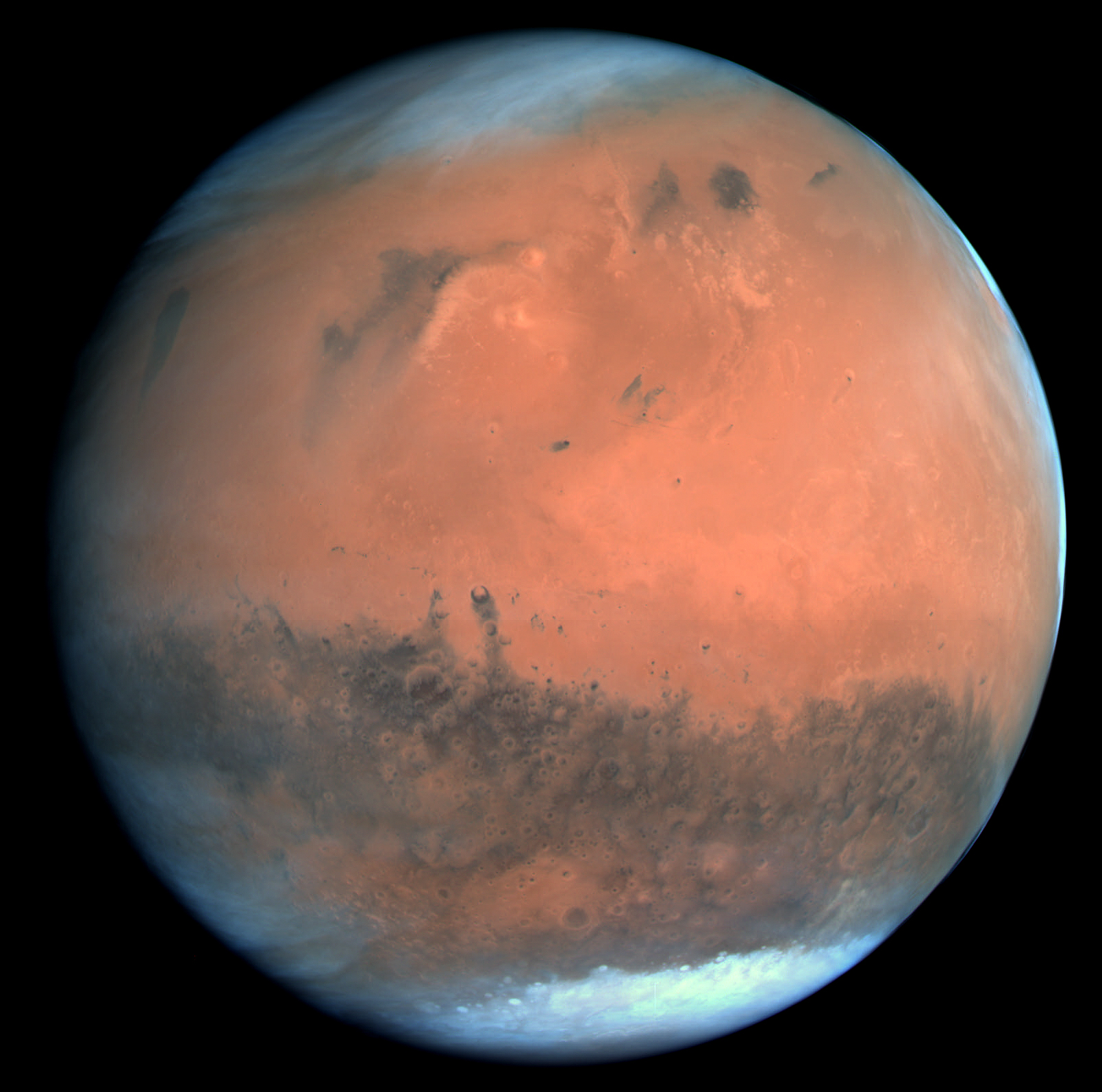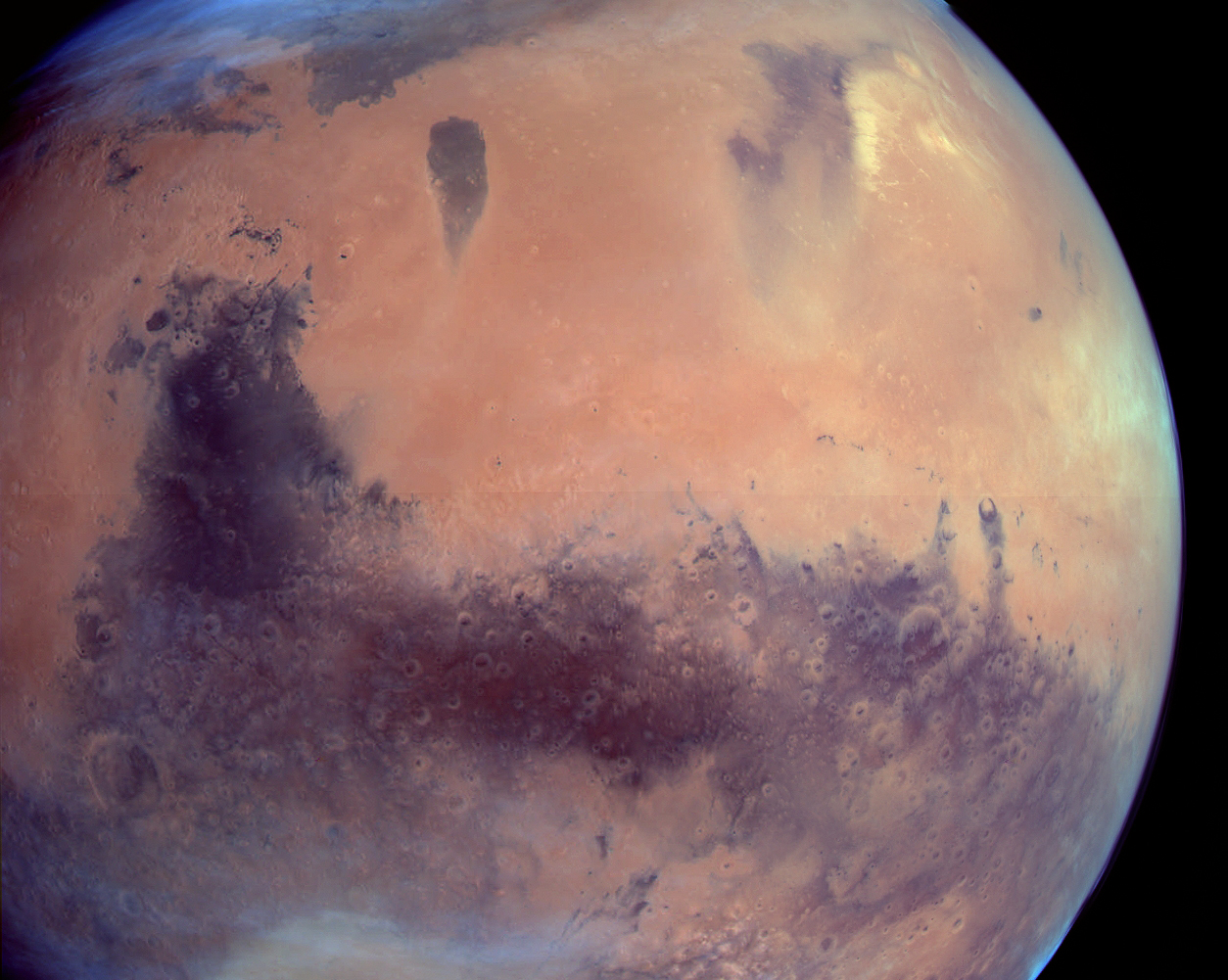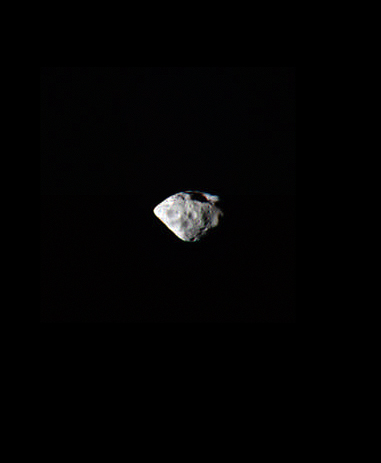It looks like you're using an Ad Blocker.
Please white-list or disable AboveTopSecret.com in your ad-blocking tool.
Thank you.
Some features of ATS will be disabled while you continue to use an ad-blocker.
share:
Before reaching the comet, Rosetta flew by Mars in 2007 and took some cool images (with its OSIRIS camera) using various filters, including
red/green/blue filters. This means one can create true-colour images from the original images found at
psa.esac.esa.int...
Here's a couple I made myself (with a tiny bit of colour and contrast adjustment):
www.pictureshack.us...

www.pictureshack.us...

I'm really wondering why there are not such images of the comet yet. Would be nice to see it in colour.
Here's a couple I made myself (with a tiny bit of colour and contrast adjustment):
www.pictureshack.us...

www.pictureshack.us...

I'm really wondering why there are not such images of the comet yet. Would be nice to see it in colour.
edit on 31-8-2014 by wildespace
because: (no reason given)
They've found that the comet is very dark in color, about like coal. Not even any white patches of fresh ice. Color photography is not likely to be of
much avail, it seems.
They have seen very faint whitish vapor jetting out of the nucleus. How this is possible, given the absence of exposed ice, is unclear. Outgassing from a comet is supposed to be caused by exposed ice subliming directly to water vapor, under the heat of the Sun.
They have seen very faint whitish vapor jetting out of the nucleus. How this is possible, given the absence of exposed ice, is unclear. Outgassing from a comet is supposed to be caused by exposed ice subliming directly to water vapor, under the heat of the Sun.
edit on 5-9-2014 by Ross 54
because: improved paragraph structure.
originally posted by: Ross 54
They've found that the comet is very dark in color, about like coal. Not even any white patches of fresh ice. Color photography is not likely to be of much avail, it seems.
They have seen very faint whitish vapor jetting out of the nucleus. How this is possible, given the absence of exposed ice, is unclear. Outgassing from a comet is supposed to be caused by exposed ice subliming directly to water vapor, under the heat of the Sun.
They didn't say that there are no patches of surface ice at all, only that there are no large patches of ice visible.
Even a dark coal-like surface can have colour, and it is guessed that this comet's surface is reddish or orange-ish in colour, due to hydrocarbons.
Cometary jets can originate from ices below the surface, if the surface is pitted / porous.
a reply to: wildespace
And,
those ices need not be water ices. There are more volatile volatiles than water.
Cometary jets can originate from ices below the surface, if the surface is pitted / porous.
And,
those ices need not be water ices. There are more volatile volatiles than water.
edit on 9/6/2014 by Phage because: (no reason given)
originally posted by: wildespace
originally posted by: Ross 54
They've found that the comet is very dark in color, about like coal. Not even any white patches of fresh ice. Color photography is not likely to be of much avail, it seems.
They have seen very faint whitish vapor jetting out of the nucleus. How this is possible, given the absence of exposed ice, is unclear. Outgassing from a comet is supposed to be caused by exposed ice subliming directly to water vapor, under the heat of the Sun.
They didn't say that there are no patches of surface ice at all, only that there are no large patches of ice visible.
Even a dark coal-like surface can have colour, and it is guessed that this comet's surface is reddish or orange-ish in colour, due to hydrocarbons.
Cometary jets can originate from ices below the surface, if the surface is pitted / porous.
Yes, that's quite true. I stand corrected. It was only large patches of exposed ices that could have been detected, but weren't. Small ice patches, or subsurface ices could be responsible for the vapor plumes.
67P C G is still at a considerable distance from the Sun, though. Volatilization of ices is presumably progressing at a slow rate. I'm hesitant to ascribe substantial vapor plumes to small or subsurface ice deposits.
It seems that we'll have to wait a bit to learn if the comet has a reddish or, orangey cast to it's very dark surface. Very few of even monochrome images are being released. This even applies to the NavCam pictures, which are taken daily. I seem to recall, too, that release of the better, Osiris camera images, were set to be released twice weekly, on Mondays and Thursdays. Very few of those have been presented on the ESA/Rosetta website.
Here's another colour image from Rosetta, before it reached the comet. This time, it's the asteroid
2867 Šteins, imaged by the OSIRIS camera on 5 September 2008:

RGB composite (hopefully in true colours) created by me from raw images
ESA blog about the asteroid: blogs.esa.int...

RGB composite (hopefully in true colours) created by me from raw images
ESA blog about the asteroid: blogs.esa.int...
This is one of the more interesting space missions of late, I just hope the orbiter and lander have zero biological contamination on board!
Getting back to the comet... WOW, this is the closest image yet, at about 1.1 meters/pixel;
www.esa.int...
The most "torturous" surface I've ever seen!
The most "torturous" surface I've ever seen!
originally posted by: wildespace
Getting back to the comet... WOW, this is the closest image yet, at about 1.1 meters/pixel; www.esa.int...
The most "torturous" surface I've ever seen!
That is superb. Humans can be pretty damn clever sometimes (and pretty damn stupid most of the time).
Yes, a fantastic landscape, like one from a wild imagination, yet it's real!
The very white patches at upper left could be small patches of snow, which have otherwise eluded detection.
The ragged promontory at the upper middle of the images has more of the fine parallel linear features, and those that cross them at right angles. Some of the vertical ones are more obvious, as shadows help define them.
These exist on the lower down rough area, as well as at the very top edge of the nucleus, where they appear on a spur or small ridge. Notable, too, is the tall, sharp spire, in this same area.
The very white patches at upper left could be small patches of snow, which have otherwise eluded detection.
The ragged promontory at the upper middle of the images has more of the fine parallel linear features, and those that cross them at right angles. Some of the vertical ones are more obvious, as shadows help define them.
These exist on the lower down rough area, as well as at the very top edge of the nucleus, where they appear on a spur or small ridge. Notable, too, is the tall, sharp spire, in this same area.
edit on 8-9-2014 by Ross 54 because: improved paragraph structure.
edit on 8-9-2014
by Ross 54 because: improved punctuation
originally posted by: Rob48
originally posted by: wildespace
Getting back to the comet... WOW, this is the closest image yet, at about 1.1 meters/pixel; www.esa.int...
The most "torturous" surface I've ever seen!
That is superb. Humans can be pretty damn clever sometimes (and pretty damn stupid most of the time).
Actually we are very much both, most of the time.
It's just that the stupidity gets reported on a daily basis while the clever quietly go about their work to make missions like this eventually happen.
originally posted by: JadeStar
originally posted by: Rob48
originally posted by: wildespace
Getting back to the comet... WOW, this is the closest image yet, at about 1.1 meters/pixel; www.esa.int...
The most "torturous" surface I've ever seen!
That is superb. Humans can be pretty damn clever sometimes (and pretty damn stupid most of the time).
Actually we are very much both, most of the time.
It's just that the stupidity gets reported on a daily basis while the clever quietly go about their work to make missions like this eventually happen.
Thanks for restoring my faith in humanity a tiny bit
originally posted by: Ross 54
The very white patches at upper left could be small patches of snow, which have otherwise eluded detection.
I think these are just smooth dusty surfaces reflecting more sunlight than the craggy surfaces. The comet is very dark overall, so any patches of ice would appear very, very bright.
The ragged promontory at the upper middle of the images has more of the fine parallel linear features, and those that cross them at right angles.
It's been proposed (at the UMSF forum, I think) that this is the comet's internal structure, exposed through erosion or outgassing. We might be looking at the comet's porous structure, seen here filled with dust and rocks.
The small bright patches I noticed were even brighter than the surrounding bright areas, which suggested the higher albedo of snow. I've read that
they had expected to find at least some exposed ice on the surface of the comet.
I haven't read the remarks about the surface texture of the comet at the Unmanned Spaceflight forum yet, but will look for them there. That site has been quite good on other aspects of 67P C G.
I'm given to wonder why random porosity would give the impression of consistently straight, parallel lines, over fairly wide areas, and even appearing at right angles to each other, in some cases.
I haven't read the remarks about the surface texture of the comet at the Unmanned Spaceflight forum yet, but will look for them there. That site has been quite good on other aspects of 67P C G.
I'm given to wonder why random porosity would give the impression of consistently straight, parallel lines, over fairly wide areas, and even appearing at right angles to each other, in some cases.
edit on 9-9-2014 by Ross 54 because: improved paragraph structure
Reviewed the Rosetta threads at the Planetary Society's Unmanned Space Flight forum, as discussed above. Didn't find anything specifically about the
connection of the comet's supposed porosity to its surface texture.
Portions of the surface have been likened to fabric, with its consistent warp and woof of fibers at right angles to each other. Another geological explanation may account for this texture, but what it would be is unclear. It would have to be workable under highly unusual conditions.
There is presumably a shallow crust of carbonaceous materials which is subject to disruption by volatilization of the underlying ice. This would occur in the absence of any real atmosphere, and with only very weak gravity.
So far as I am aware, the multitude of straight and parallel lines seen on the surface of 67P C G have not been discerned on other comets which have been closely examined.
Portions of the surface have been likened to fabric, with its consistent warp and woof of fibers at right angles to each other. Another geological explanation may account for this texture, but what it would be is unclear. It would have to be workable under highly unusual conditions.
There is presumably a shallow crust of carbonaceous materials which is subject to disruption by volatilization of the underlying ice. This would occur in the absence of any real atmosphere, and with only very weak gravity.
So far as I am aware, the multitude of straight and parallel lines seen on the surface of 67P C G have not been discerned on other comets which have been closely examined.
edit on 10-9-2014 by Ross 54 because: corrected spelling and capitalization error
edit on 10-9-2014 by
Ross 54 because: improved paragraph structure
A primary and secondary landing site have been selected for the Philae lander, it was announced this morning. The prime site, designated 'J', but soon
now to have a proper name, is in a relatively flat area, near the edge of the large crater-like feature on the 'head' lobe of the comet's nucleus. It
is also near two small pits, believed to be sites of venting of gases, sublimed directly from volatile ices. The article, linked below, has further
details, together with photographs of the primary landing site.
www.skyandtelescope.com...
www.skyandtelescope.com...
edit on
15-9-2014 by Ross 54 because: corrected misspelled word
a reply to: boymonkey74
Oh and I wanna lick that old thing to see what it tastes like.
Cool mission and photos I can't wait to see more.
Oh and I wanna lick that old thing to see what it tastes like.
Cool mission and photos I can't wait to see more.
new topics
-
James O’Keefe: I have evidence that exposes the CIA, and it’s on camera.
Whistle Blowers and Leaked Documents: 30 minutes ago -
Australian PM says the quiet part out loud - "free speech is a threat to democratic dicourse"...?!
New World Order: 1 hours ago -
Ireland VS Globalists
Social Issues and Civil Unrest: 1 hours ago -
Biden "Happy To Debate Trump"
Mainstream News: 2 hours ago -
RAAF airbase in Roswell, New Mexico is on fire
Aliens and UFOs: 2 hours ago -
What is the white pill?
Philosophy and Metaphysics: 3 hours ago -
Mike Pinder The Moody Blues R.I.P.
Music: 4 hours ago -
Putin, Russia and the Great Architects of the Universe
ATS Skunk Works: 7 hours ago
top topics
-
President BIDEN's FBI Raided Donald Trump's Florida Home for OBAMA-NORTH KOREA Documents.
Political Conspiracies: 17 hours ago, 35 flags -
A Warning to America: 25 Ways the US is Being Destroyed
New World Order: 12 hours ago, 20 flags -
Mike Pinder The Moody Blues R.I.P.
Music: 4 hours ago, 7 flags -
Australian PM says the quiet part out loud - "free speech is a threat to democratic dicourse"...?!
New World Order: 1 hours ago, 5 flags -
What is the white pill?
Philosophy and Metaphysics: 3 hours ago, 5 flags -
Biden "Happy To Debate Trump"
Mainstream News: 2 hours ago, 5 flags -
RAAF airbase in Roswell, New Mexico is on fire
Aliens and UFOs: 2 hours ago, 4 flags -
Putin, Russia and the Great Architects of the Universe
ATS Skunk Works: 7 hours ago, 3 flags -
Ireland VS Globalists
Social Issues and Civil Unrest: 1 hours ago, 2 flags -
James O’Keefe: I have evidence that exposes the CIA, and it’s on camera.
Whistle Blowers and Leaked Documents: 30 minutes ago, 1 flags
active topics
-
James O’Keefe: I have evidence that exposes the CIA, and it’s on camera.
Whistle Blowers and Leaked Documents • 6 • : chiefsmom -
University of Texas Instantly Shuts Down Anti Israel Protests
Education and Media • 289 • : KrustyKrab -
Gaza Terrorists Attack US Humanitarian Pier During Construction
Middle East Issues • 85 • : FlyersFan -
Supreme Court Oral Arguments 4.25.2024 - Are PRESIDENTS IMMUNE From Later Being Prosecuted.
Above Politics • 100 • : Vermilion -
Russia Ukraine Update Thread - part 3
World War Three • 5735 • : gortex -
"We're All Hamas" Heard at Columbia University Protests
Social Issues and Civil Unrest • 288 • : FlyersFan -
Biden "Happy To Debate Trump"
Mainstream News • 31 • : theatreboy -
President BIDEN's FBI Raided Donald Trump's Florida Home for OBAMA-NORTH KOREA Documents.
Political Conspiracies • 33 • : theatreboy -
Hate makes for strange bedfellows
US Political Madness • 52 • : YourFaceAgain -
-@TH3WH17ERABB17- -Q- ---TIME TO SHOW THE WORLD--- -Part- --44--
Dissecting Disinformation • 697 • : Thoughtful3
